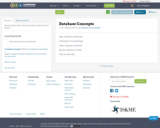
To know about what is data, information, table, field and Record
- Subject:
- Career and Technical Education
- Material Type:
- Lecture Notes
- Date Added:
- 07/20/2016

To know about what is data, information, table, field and Record
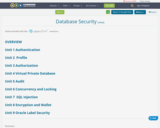
Database Security is the utmost key part for any type of database, .for example financial information, personal information, employee information and enterprise information. This book will cover following topics such as creating and altering database user, password profiling, various privileges and virtual private database. All the topics are implemented by using oracle 11g software. Especially for readers this book will give clarity about database security concepts such as Authorization, Authentication and Access control. The practical part using oracle provides how to carry out database security concepts technically for the reader.
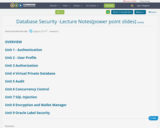
Database Security is the utmost key part for any type of database, .for example financial information, personal information, employee information and enterprise information. This book will cover following topics such as creating and altering database user, password profiling, various privileges and virtual private database. All the topics are implemented by using oracle 11g software. Especially for readers this book will give clarity about database security concepts such as Authorization, Authentication and Access control. The practical part using oracle provides how to carry out database security concepts technically for the reader.
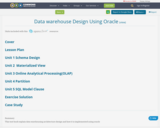
This text book explain data warehousing architecture design and how it is implemented using oracle

This course explores natural and electric lighting that integrates occupant comfort, energy efficiency and daylight availability in an architectural context. Students are asked to evaluate daylighting in real space and simulations, and also high dynamic range photography and physical model building.
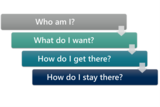
This resource from the Washington Center for Deaf and Hard of Hearing Youth provides guiding questions and resources to help student reach their full potential as they work towards their post high school and transition goals.
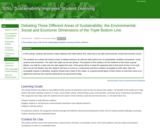
In this activity, students will choose a topic relating to the triple bottom line, which has to do with environmental, social and economic issues.
The students as a whole will choose a topic of debate having to do with the triple bottom line of sustainability: healthier ecosystems, social systems and economies. The class then splits up into two groups. The purpose of this activity is for the students to then have a group debate, one side for a topic and one side against the topic. Each group will try to sway the opposing side to their point of view. If one side does not win the debate, then the students will have to come to a compromise and find a solution acceptable to both sides. After the acceptable solution is identified, students should write a letter to the mayor, or a governmental figure of their choice on how they came to an agreement and how this could be achieved by our government today.
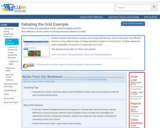
Students research electricity, its sources, how energy grids function, how to make grids most efficient, and how to bring different types of energy generation together to diversify grids. Students debate the costs and benefits of moving to a modernized Smart Grid.

This website guidance document describes the Debt Slapped project, produced by Consumer Education and Training Services. Debt Slapped provides videos and helpful resource links to help people smartly finance their education.
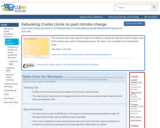
This humorous short video uses the 'single-cause fallacy' to debunk the myth that current changes in the Earth's climate are a result of natural phenomenon. The video is one of several in the 'Cranky Uncle' series.
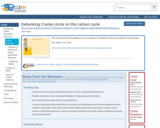
This video illustrates the Keeling curve as evidence to establish man's role in global climate change.

Learn more about the decision making process, and how you can make informed decisions.
Footage: pexels.com

Learn more about the decision making process, and how you can make informed decisions. Footage: pexels.com

Learn more about the decision making process, and how you can make informed decisions. Footage: pexels.com
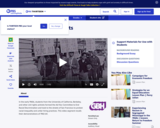
This video segment, adapted from Decision in the Streets by civil rights filmmaker Harvey Richards, portrays the interracial protests that took place in San Francisco in 1963-64.
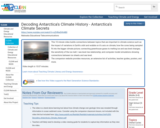
This 10 minute video builds connections between topics that are important in climate science such as: the impact of variations in Earth's orbit and wobble on it's axis on climate; how the cores being sampled fit into the bigger climate picture; connecting greenhouse gases to melting ice and sea level changes; the sensitivity of the ice melt / sea level rise relationship; and computer model simulations showing connections between ice sheets and sea level.
The companion website provides resources, an extensive list of activities, teacher guides, posters, and more.
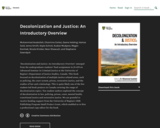
Short Description:
'Decolonization and Justice: An Introductory Overview' emerged from the undergraduate students’ final assignment in JS-419 on Advanced Seminar in Criminal Justice at the University of Regina's Department of Justice Studies, Canada. This book focused on decolonization of multiple justice-related areas, such as policing, the court system, prison, restorative justice, and the studies of law and criminology. This is quite likely one of the few student-led book projects in Canada covering the range of decolonization topics. Ten student authors explored the concept of decolonization in law, policing, prison, court, mental health, transitional justice and restorative justice. We are grateful to receive funding support from the University of Regina’s OER Publishing Program Small Project Grant, which enabled us to hire a professional copy editor for the book.
Long Description:
‘Decolonization and Justice: An Introductory Overview’ emerged from the undergraduate students’ final assignment in JS-419 on Advanced Seminar in Criminal Justice at the University of Regina’s Department of Justice Studies, Canada. This book focused on decolonization of multiple justice-related areas, such as policing, the court system, prison, restorative justice, and the studies of law and criminology. This is quite likely one of the few student-led book projects in Canada covering the range of decolonization topics. Ten student authors explored the concept of decolonization in law, policing, prison, court, mental health, transitional justice and restorative justice. We are grateful to receive funding support from the University of Regina’s OER Publishing Program Small Project Grant, which enabled us to hire a professional copy editor for the book.
Word Count: 79111
(Note: This resource's metadata has been created automatically by reformatting and/or combining the information that the author initially provided as part of a bulk import process.)
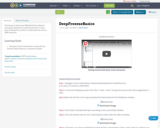
This lesson is taken from Widefield School District technology department training materials. It is has been developed in an effort to understand the tools in OER Commons
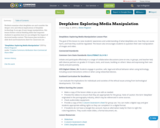
Students examine what deepfakes are and consider the deeper civic and ethical implications of deepfake technology. In an age of easy image manipulation, this lesson fosters critical thinking skills that empower students to question how we can mitigate the impact of doctored media content. This lesson plan includes a slide deck and brainstorm sheet for classroom use.
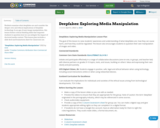
Students examine what deepfakes are and consider the deeper civic and ethical implications of deepfake technology. In an age of easy image manipulation, this lesson fosters critical thinking skills that empower students to question how we can mitigate the impact of doctored media content. This lesson plan includes a slide deck and brainstorm sheet for classroom use.